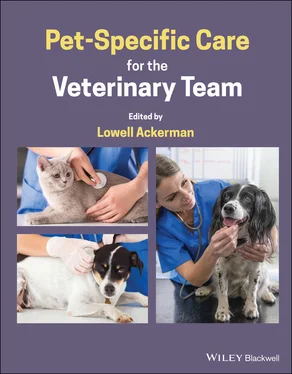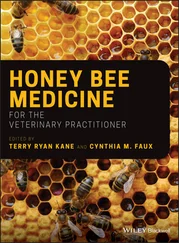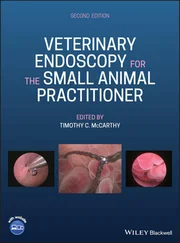17 Section 10: Practice Management Considerations 10.1 Strategies for Success with Pet-Specific Care BASICS MAIN CONCEPTS EXAMPLES TAKE‐AWAYS MISCELLANEOUSRecommended Reading 10.2 The Importance of Practice Differentiation BASICS MAIN CONCEPTS EXAMPLES TAKE‐AWAYS MISCELLANEOUS Recommended Reading 10.3 Pet‐Specific Outreach BASICS MAIN CONCEPTS EXAMPLES TAKE‐AWAYS MISCELLANEOUS References 10.4 Client and Patient Segmentation BASICS MAIN CONCEPTS TAKE‐AWAYS CAUTIONS MISCELLANEOUSRecommended Reading 10.5 Early Detection Campaigns BASICS MAIN CONCEPTS EXAMPLES TAKE‐AWAYS MISCELLANEOUSRecommended Reading 10.6 Target Marketing and Targeted Client Outreach BASICS MAIN CONCEPTS EXAMPLES TAKE‐AWAYS MISCELLANEOUS Recommended Reading 10.7 Breed‐Specific Marketing BASICS MAIN CONCEPTS TAKE‐AWAYS MISCELLANEOUS Recommended Reading 10.8 Using Practice Data as a Credibility‐Boosting Tool BASICS MAIN CONCEPTS EXAMPLES TAKE‐AWAYS MISCELLANEOUSReferences Recommended Reading 10.9 Laboratory Considerations BASICS MAIN CONCEPTS TAKE‐AWAYS MISCELLANEOUSReference Recommended Reading 10.10 Making Referrals Work BASICS MAIN CONCEPTS TAKE‐AWAYS MISCELLANEOUS Recommended Reading 10.11 Financial Benefits of Pet‐Specific Care BASICS MAIN CONCEPTS EXAMPLES TAKE‐AWAYS MISCELLANEOUSReferences 10.12 Dashboards and Key Performance Indicators BASICS MAIN CONCEPTS EXAMPLES TAKE‐AWAYS MISCELLANEOUS Reference Recommended Reading 10.13 Approach to Pricing BASICS MAIN CONCEPTS TAKE‐AWAYS MISCELLANEOUSReferences Recommended Reading 10.14 Providing Cost‐Effective Care for Those in Need BASICS MAIN CONCEPTS EXAMPLES TAKE‐AWAYS MISCELLANEOUSReferences Recommended Reading 10.15 Putting Price into Perspective BASICS MAIN CONCEPTS EXAMPLES TAKE‐AWAYS MISCELLANEOUS Recommended Reading 10.16 Pet Health Insurance BASICS MAIN CONCEPTS EXAMPLES TAKE‐AWAYS MISCELLANEOUS References Recommended Reading 10.17 Payment and Wellness Plans BASICS MAIN CONCEPTS EXAMPLES TAKE‐AWAYS MISCELLANEOUS References Recommended Reading 10.18 Financing Veterinary Care BASICS MAIN CONCEPTS Recommended Reading
18 Section 11: Appendices 11.1 Finding More Information on Pet‐Specific Care Topics Additional Book Resources Website Resources Pet Information and Images 11.2 Abbreviations 11.3 Heritable Health Conditions – By Disease Recommended Reading 11.4 Heritable Health Conditions by Breed Recommended Reading 11.5 Life Planning by Breed Recommended Reading 11.6 Glossary
19 Index
20 End User License Agreement
1 Chapter 1-2 Table 1.2.1 Approximation for converting “dog” years to relative human years,... Table 1.2.2 Approximation for converting “cat” years to relative human years ...
2 Chapter 1-3 Table 1.3.1 Some common breeds and a few of the conditions to which they are ... Table 1.3.2 Further testing that might be indicated based on perceived risk
3 Chapter 2-4 Table 2.4.1 Sample surgical safety checklist for use by veterinary practices ...
4 Chapter 2-9 Table 2.9.1 Approximate cost of preventive and end‐of‐life care for dogs livi... Table 2.9.2 Approximate cost of preventive and end‐of‐life care for cats livi...
5 Chapter 2-19 Table 2.19.1 One Health resources
6 Chapter 3-3 Table 3.3.1 The genetics of coat color
7 Chapter 3-7 Table 3.7.1 The top 11 breeds with the highest prevalence of elbow dysplasia ... Table 3.7.2 Health information on a dog of interest along with that of its si... Table 3.7.3 Genetic test screenings recorded in the OFA Canine Health Informa...
8 Chapter 3-9 Table 3.9.1 Examples of some canine hybrid crosses
9 Chapter 3-10 Table 3.10.1 A sample of dog and cat breed selector tools found on the intern... Table 3.10.2 Golden retriever adoption questionnaire
10 Chapter 3-11 Table 3.11.1 Some of the genotypic tests currently available
11 Chapter 3-18Table 3.18.1 Some dog breeds predisposed to developing hereditary cataractsTable 3.18.2 Some dog breeds with heritable lens luxationTable 3.18.3 Some dog breeds predisposed to heritable progressive retinal atr...Table 3.18.4 Some dog breeds predisposed to primary glaucoma
12 Chapter 3-19Table 3.19.1 Conditions commonly seen in mixed‐breed pets
13 Chapter 4-4Table 4.4.1 Hand hygiene protocols
14 Chapter 5-6Table 5.6.1 Pros and cons of acquiring a pet from an animal shelterTable 5.6.2 Pros and cons of adopting a pet from a pet rescueTable 5.6.3 Pros and cons of acquiring a pet from a reputable breeder
15 Chapter 5-11Table 5.11.1 Top stressors in veterinary practice [1]Table 5.11.2 Alternative wording for phrases that should be avoided in practi...
16 Chapter 5-13Table 5.13.1 Comparing client app and phone communication preferencesTable 5.13.2 Client preferences for patient update frequency Table 5.13.3Client device preferences for receiving patient updates
17 Chapter 6-1Table 6.1.1 Developmental stages in dogs and cats
18 Chapter 6-4Table 6.4.1 Example of a grid for ABC Animal Hospital, whose standard of care...
19 Chapter 6-19Table 6.19.1 DISHAA explainedTable 6.19.2 Commercially available diets, supplements, and medications
20 Chapter 6-20Table 6.20.1 Typical components considered in a quality of life (QOL) assessm...
21 Chapter 7-5Table 7.5.1 Examples of marketing contentTable 7.5.2 Example of video length on different platforms
22 Chapter 7-11Table 7.11.1 Examples of nonchemotherapeutic medications that may have the po...
23 Chapter 8-16Table 8.16.1 Characteristics of compassion fatigue and burnout.
24 Chapter 8-26Table 8.26.1 Breeds commonly prone to primary glaucoma
25 Chapter 9-12Table 9.12.1 Efficacy of antimicrobials in abscessesTable 9.12.2 Postantibiotic effectsTable 9.12.3 Effect of antimicrobials on bacteria
26 Chapter 9-13Table 9.13.1 Preanesthetic checklist [1]Table 9.13.2American Society of Anesthesiologists (ASA) physical status
27 Chapter 10-8Table 10.8.1 Example: occurrence of feline diabetes
1 Chapter 1-2 Figure 1.2.1 Example of a canine risk assessment form.
2 Chapter 1-3 Figure 1.3.1 Example of a personalized care plan.
3 Chapter 2-1 Figure 2.1.1 An evidence pyramid illustrating the variable reliability and r...
4 Chapter 2-19 Figure 2.19.1 A graphic representation of the One Health concept.
5 Chapter 3-1 Figure 3.1.1 Double helix structure of DNA.
6 Chapter 3-4 Figure 3.4.1 Topics to be addressed in puppy/kitten client discussions.
7 Chapter 3-5 Figure 3.5.1 Flat‐faced animals may experience a large number of health prob... Figure 3.5.2 Excessive skinfolds cause disease and eye problems. Figure 3.5.3 Short legs of a bassett compared to… Figure 3.5.4 …a normal straight leg.
8 Chapter 3-15Figure 3.15.1 Fully conscious brachycephalic dog with endotracheal tube stil...
9 Chapter 3-16Figure 3.16.1 Sulfonamide adverse drug reaction.
10 Chapter 4-9Figure 4.9.1 Periodontal probe.Figure 4.9.2 Horizontal bone loss.Figure 4.9.3 Vertical bone loss.
11 Chapter 6-15Figure 6.15.1 Canine body condition score.Figure 6.15.2 Feline body condition score.
12 Chapter 8-8Figure 8.8.1 Six steps to writing a care bundle.Figure 8.8.2 Principles for implementing care bundles.
13 Chapter 8-11Figure 8.11.1 Feline dental chart.Figure 8.11.2 Canine dental chart.Figure 8.11.3 Modified Triadan Numbering.Figure 8.11.4 Type 2 TR.Figure 8.11.5 Type 1 TR.
14 Chapter 8-18Figure 8.18.1 One of the first manifestations of atopic dermatitis is often ...
15 Chapter 8-20Figure 8.20.1 COAST stages.
16 Chapter 8-21Figure 8.21.1 The team approach to pet pain management includes the receptio...
17 Chapter 8-23Figure 8.23.1 A common lesion of pyoderma in dogs is a peeling rim of scale ...
18 Chapter 8-24Figure 8.24.1 Basic anatomy of the canine ear.Figure 8.24.2 It is important to be proactive when managing cases of otitis ...
Читать дальше












